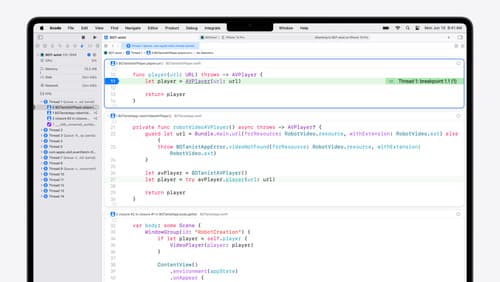How the SwiftUI state management changed in iOS 17?
Asked on 2024-08-06
1 search
In iOS 17, SwiftUI state management has seen several enhancements and changes:
-
State-Driven Views: SwiftUI continues to emphasize state-driven views, where changes in view state automatically update the UI. This eliminates boilerplate code and reduces update bugs. SwiftUI maintains a representation of the user interface behind the scenes, updating outputs based on data changes (SwiftUI essentials).
-
State and Binding: The use of
@Stateand@Bindingremains central.@Statecreates a new internal source of data for a view, while@Bindingcreates a two-way reference to the state of another view. This allows for more synchronized updates across different parts of the UI (SwiftUI essentials, SwiftUI essentials). -
Main Actor Isolation: Views in SwiftUI are now marked with the
@MainActorannotation, meaning all types conforming toVieware implicitly isolated to the main actor by default. This change simplifies concurrency management by ensuring that UI updates happen on the main thread (What’s new in SwiftUI). -
Swift 6 Language Mode: The new Swift 6 language mode introduces compile-time data race safety, which is supported by improved SwiftUI APIs. This mode helps developers catch concurrency issues early in the development process (What’s new in SwiftUI).
These changes collectively enhance the robustness and ease of use of state management in SwiftUI, making it easier to build responsive and bug-free user interfaces.

What’s new in SwiftUI
Learn how you can use SwiftUI to build great apps for any Apple platform. Explore a fresh new look and feel for tabs and documents on iPadOS. Improve your window management with new windowing APIs, and gain more control over immersive spaces and volumes in your visionOS apps. We’ll also take you through other exciting refinements that help you make expressive charts, customize and layout text, and so much more.

What’s new in Xcode 16
Discover the latest productivity and performance improvements in Xcode 16. Learn about enhancements to code completion, diagnostics, and Xcode Previews. Find out more about updates in builds and explore improvements in debugging and Instruments.

SwiftUI essentials
Join us on a tour of SwiftUI, Apple’s declarative user interface framework. Learn essential concepts for building apps in SwiftUI, like views, state variables, and layout. Discover the breadth of APIs for building fully featured experiences and crafting unique custom components. Whether you’re brand new to SwiftUI or an experienced developer, you’ll learn how to take advantage of what SwiftUI has to offer when building great apps.
